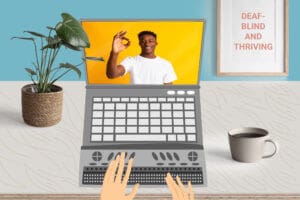
How to Improve Accessibility for DeafBlind People
How to Improve Accessibility for DeafBlind People
DeafBlindness is not often explored or discussed in mainstream hearing or sighted society. For this reason, many people still don’t know what DeafBlindness is.
Like deafness, DeafBlindness is a spectrum. Some people who are DeafBlind are deaf but have some vision; others are blind and have some hearing. Others still are profoundly deaf and blind.
Depending on their level of hearing and sight, DeafBlind people use a broad range of communication methods including speech, sign languages – including tactile and DeafBlind fingerspelling – print, and braille.
Improving Awareness
Because of the lack of awareness around deafblindness, access to many everyday things can be challenging for DeafBlind people. Experiences like going out for food, taking a walk or communicating with strangers can present multiple barriers.
Thankfully, media accessibility for DeafBlind audiences is making progress. The internet has opened up many more opportunities for access to information and communication for DeafBlind people. But there is still a great deal of work to be done.
Essential DeafBlind Accessibility Tips
There are a few essential things to be aware of when communicating with a DeafBlind person, whether it is online or in person.
- Remember to be flexible and communicate using the method that the person who is DeafBlind requires. Be responsive to what they are telling you about their communication style. If the person wants to communicate using text on their phone or a pad, use that option. If the person is pointing or gesturing to indicate something, be attentive to this. Some people will prefer to use touch to communicate.
- Do not assume that the person can see or hear you.
- In terms of digital accessibility, make sure you have added alt text to all your digital images on any websites and social media, and provide transcripts and/or audio description for videos. Use captions that are clear and large whenever possible.
Abby’s 5 Accessibility Tips for Video
Abby Sienko is a DeafBlind person who has talked about the pride she takes in being ‘part of two worlds’. She speaks in the below video about how to make video content accessible for people who are DeafBlind.
1. Wear full-colored clothes, especially if signing.
This helps DeafBlind people with low vision to see your face, your expressions, and any signing.
2. Have a clear background with minimal distractions.
Busy or patterned backgrounds can make things harder to see and can distract from the focus of the video. Make sure your setting is as simple as possible.
3. Make sure there is good lighting.
Again, good visibility is of the utmost importance. Make sure you are well-lit.
4. If you are using sign language, maintain a decent signing space.
Make sure your signing space is big enough to see all your movements, but not so big that people with low vision can’t see where your hands are going.
5. Most importantly, include a transcript.
This one is essential, because most DeafBlind people will have some difficulty seeing the video. Some may be blind and will need an alternative way to access the content. Transcripts address this as they can be read by a screen reader.
You’re On Your Way
Great work! You’ve started your accessibility journey for DeafBlind people.
You can find more information on DeafBlindness at the National Center on Deaf-Blindness website.
And for any accessibility services you might need – including transcription, captioning, or audio description – get in touch with us at Ai-Media, or visit our website.